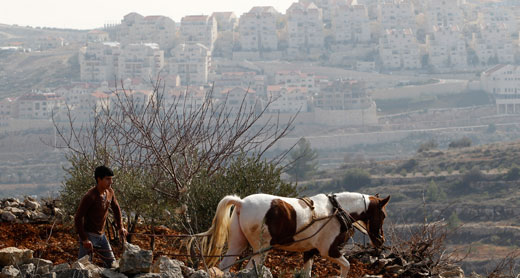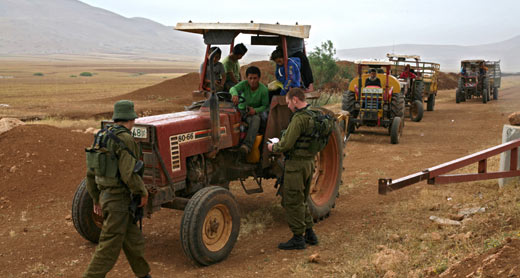Legal pretence of temporary occupation

Israel in the West Bank: A 47-year-long temporary occupation
Report from B’Tselem
June 05, 2014
At times the occupation seems to be a thing of the past. Women in labor detained at checkpoints for so long that they end up giving birth there are no longer a common occurrence; there are fewer incidents of killings, violence and destruction. Israel is no longer involved in determining the scholastic curricula for Palestinian schoolchildren and Israeli troops are no longer permanently stationed in the streets and alleys of the city of Nablus. Instead, we hear reports of Palestinians building a new city in the West Bank and about Israel and the Palestinian Authority cooperating on security-related issues.
Nevertheless, after nearly half a century, the occupation is still going strong. A third, and even fourth, generation of Palestinians and Israelis has been born into this reality, and they know no other. The Oslo Accords, signed over two decades ago, brought about the establishment of the Palestinian Authority and with it the illusion that Israel’s impact on the lives of Palestinians would henceforth be no more than negligible. Yet, to this day, Israel is the most dominant factor influencing the daily lives of all residents of the West Bank.
Settlements: The heart of the matter

The Jewish settlement of Efrat looms over a Palestinian farmer ploughing his land. Photo by Baz Ratner, Reuters, December 22, 2011.
Israeli settlements are currently the major factor influencing the reality of life in the West Bank: over 300,000 Israeli citizens live in more than 200 settlements and settlement outposts throughout the West Bank, all established in contravention of international humanitarian law, some even in contravention of Israeli law.
Tens of thousands of hectares of land, including pastureland and farmland, have been seized from Palestinians for the express purpose of building settlements. A significant portion of these lands has been declared state land, based on a dubious interpretation of the law; other areas have been usurped from Palestinians by force and strong-arm tactics and by actual construction that would make the settlement seem a fait accompli. In addition, settlements have been granted generous allocations of land, far exceeding their built-up areas. All lands allocated to settlements – built-up area and environs – have been designated closed military zones which Palestinians may not enter without a permit.
The impact the settlements have on Palestinians’ human rights is above and beyond the land seized for the actual settlements: additional lands were confiscated from Palestinians to build hundreds of kilometers of bypass roads for the settlers; checkpoints and other measures that restrict only Palestinian movement were set up based on the placement of settlements; much Palestinian farmland – both in and outside the settlements – has become effectively off-limits to its Palestinian owners; and the tortuous, meandering route of the Separation Barrier in the West Bank was planned primarily to keep as many settlements and large areas designated by Israel for their expansion west of the barrier, on its “Israeli side”. The current route of the barrier leads to severe violations of the rights of Palestinians living in its vicinity, some of whom have ended up trapped in enclaves. The barrier disrupts their lives, limiting their access to farmland, essential services and to friends and relatives who have remained on the other side. It also precludes any possibility for development in these areas.
The presence of Israeli citizens in the West Bank and the settlements and outposts scattered throughout it are the main reason for the massive presence of Israeli security forces there. Israel devotes a great deal of resources to ensure that Palestinians not violate the military orders designed to keep them away from settlements and to keeping Palestinians from attacking settlers or settlements – attacks that are both immoral and unlawful, the fact that the settlements are a breach of international humanitarian law notwithstanding . The presence of security forces results in daily friction between Israeli troops and Palestinian residents. This, in turn, leads to human rights violations by security forces, including acts of violence and illegal gunfire.
Although the West Bank is not part of Israel’s sovereign territory, Israel has applied the lion’s share of its legal system to settlements and settlers. As a result, settlers benefit from all the rights granted to citizens of a democratic country, as do the rest of Israel’s citizens who live within the boundaries of the Green Line, the 1949 Armistice Line.
The Oslo Accords: An illusion of autonomy

Children of the Jahalin tribe. Israel plans to expel the area’s Bedouin villagers to expand the settlement of Ma’ale Adumim (background) Photo from report.
Contrary to their express purpose, the Oslo Accords have actually enabled Israel to cement its control over the entire West Bank, use it for its own purposes and influence significant aspects of the daily lives of its Palestinian residents.
How? Control of the West Bank was to be split for an interim period, planned to last five years until a permanent agreement was signed: about 40% of the West Bank were defined as Areas A and B and handed over to the Palestinian Authority for its full or partial control. This land was mostly built-up Palestinian areas and already home to the vast majority of the Palestinian population. Israel retained full control of the remaining 60% of the West Bank, Area C, which included all settlement areas.
Israel treats Area C as if its sole purpose is to serve its needs alone, completely ignoring the temporary nature of the agreement. Israel has used this territory to expand the settlements, and their population has more than tripled since the Accords were signed. At the same time, it does not consider itself obligated in any way to the estimated 200,000-300,000 Palestinians living in this area. Citing a variety of grounds, Israel denies virtually all construction and development by Palestinians in Area C. Israel has declared vast areas in the West Bank military zones and state land, where building is prohibited. In the few remaining areas, the Civil Administration refrains from drafting master plans that reflect the needs of the population. When, having no other option, Palestinians build without permits, the Civil Administration threatens to demolish the homes, and in some cases, delivers on this threat.
One of this policy’s objectives is to drive Palestinians out of Area C, at least in part to facilitate its future annexation to Israel. The policy takes on a particularly violent slant in the way Israel treats dozens of semi-nomadic communities scattered throughout Area C, expelling or attempting to expel residents of these communities from their homes and local setting.
Areas A and B, the lands handed over to the Palestinian Authority, are not contiguous; they are made up of nearly 170 “islands” surrounded by land designated Area C. Consequently, although the vast majority of the Palestinian residents of the West Bank live in Areas A and B, all the land reserves required for developing their communities remain in Area C, including many lands that were once within the municipal jurisdiction of these communities, some of them privately owned. Any use of these lands for expanding communities in Areas A and B or for building industrial plants, laying down water pipes or roads, is subject to Israeli approval, which is, for the most part, withheld.
Israel also continues to exercise individual control over each and every resident of the West Bank, despite their ostensible status as subject to the Palestinian Authority. In order for Palestinians to get from one city to another or from one area to another, they must pass through areas that are under full Israeli control, meaning that they must come into contact with Israeli security forces. These forces often make incursions into Areas A and B, mostly in coordination and cooperation with the Palestinian Authority. Israel also continues to control the population registry and to decide who is considered a resident of the West Bank. It has also retained the military legal system in the West Bank, trying thousands of Palestinians – including residents of Areas A and B – in military courts each year. In addition, no Palestinian resident of the West Bank may travel abroad without Israeli approval nor may foreign nationals enter the West Bank without Israeli permission. The Israeli authorities are authorized to arrest and deport them, even if they are in Areas A and B.
“Provisional military occupation”?

Soldiers detain farmers on dirt road leading to the towns Tammun and Tubas, west of the Jordan Valley. Photo: Keren Manor, activestills.org, 28 April 2011
Israel gained control over the West Bank by military force in an armed conflict. The West Bank’s permanent status remains undetermined to this day, and it is subject to Israeli military rule – termed “occupation”.
Despite the political and emotional connotations of the word “occupation”, it is first and foremost a legal term that describes the status of a territory that was seized by a state during an armed conflict and is not a part of its own sovereign territory. At present, there is hardly any dispute among international legal scholars, Israel’s Supreme Court justices and top military officials that Israel’s obligations and powers in the West Bank are determined by the law of occupation. Since international law prohibits the annexation of a territory by force, according to this law, the occupying state does not gain sovereignty over the occupied territory and its control there is meant to be temporary, pending a diplomatic agreement that determines the status of the territory.
However, Israel’s actions on the ground indicate that it does not see the occupation as temporary. It apparently considers the West Bank, and particularly Area C, as its own, a part of its sovereign territory: seizing lands, using natural resources for itself and establishing permanent settlements. At the same time, Israel evades the obligations it has under the law of occupation toward Palestinian residents of the West Bank, who are permitted to build on only about 40% of its territory, including the obligation to safeguard them, uphold their right to property and allow them to exercise their rights to housing, welfare and livelihood.
Over the years, Israel has gradually created two separate regimes in the West Bank, dependent on national identity: one for settlers and the other for Palestinians. The settlers enjoy all the rights granted to citizens of a democratic country. In contrast, Palestinians live under a harsh military rule which primarily serves the interests of Israel and the settlers. Palestinians are subject to military orders that restrict them and impinge on their rights. Likewise, they are unable to participate in the election of the Israeli officials serving in bodies responsible for making decisions applicable to them.
* * *
Israeli occupation is here to stay
By taking advantage of a legal framework appropriate for short-term situations, Israel has produced a state of affairs in the West Bank that has not merely disinherited, stifled and trampled human rights for nearly half a century but also reveals Israel’s sweeping, long-term objectives. While the illusion that the current situation can be carried on indefinitely grows stronger, the reality in the West Bank reinforces the permanent state of injustice which inevitably brings about daily violations of the human rights of Palestinians living under occupation. This reality cannot change unless the occupation is brought to an end.
